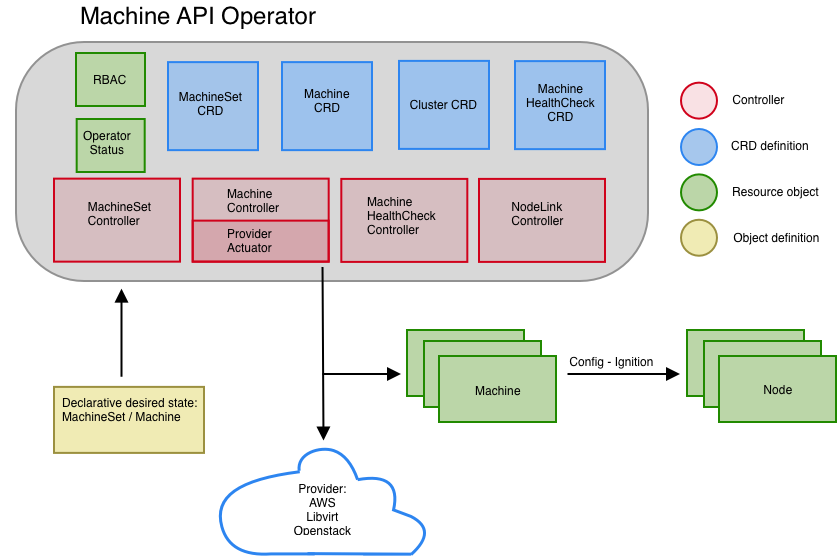The Machine API Operator manages the lifecycle of specific purpose CRDs, controllers and RBAC objects that extend the Kubernetes API. This allows to convey desired state of machines in a cluster in a declarative fashion.
See https://github.com/openshift/enhancements/tree/master/enhancements/machine-api for more details.
Have a question? See our Frequently Asked Questions for common inquiries.
- MachineSet
- Machine
- MachineHealthCheck
-
MachineSet Controller
Ensure presence of expected number of replicas and a given provider config for a set of machines.
-
Machine Controller
Ensure that a provider instance is created for a Machine object in a given provider.
-
Nodelink Controller
Ensure machines have a nodeRef based on IPs or providerID matching. Annotate nodes with a label containing the machine name.
-
MachineHealthCheck Controller
Ensure machines targeted by MachineHealthCheck objects satisfy a healthiness criteria or are remediated otherwise.
You can create a new machine by applying a manifest representing an instance of the machine CRD
The machine.openshift.io/cluster-api-cluster label will be used by the controllers to lookup for the right cloud instance.
You can set other labels to provide a convenient way for users and consumers to retrieve groups of machines:
machine.openshift.io/cluster-api-machine-role: worker
machine.openshift.io/cluster-api-machine-type: worker
-
Generate code (if needed):
$ make generate
-
Build:
$ make build
-
Run:
Extract images.json to a file from
install/0000_30_machine-api-operator_01_images.configmap.yamland run:$ ./bin/machine-api-operator start --kubeconfig ${HOME}/.kube/config --images-json=path/to/images.json -
Image:
$ make image
The Machine API Operator is designed to work in conjunction with the Cluster Version Operator. You can see it in action by running an OpenShift Cluster deployed by the Installer.
However you can run it in a vanilla Kubernetes cluster by precreating some assets:
- Create a
openshift-machine-apinamespace - Create a CRD Status definition
- Create a CRD Machine definition
- Create a CRD MachineSet definition
- Create a Installer config
- Then you can run it as a deployment
- You should then be able to deploy a machineSet object
For more information see hacking-guide.
INFO: For development and testing purposes only
- Deploy MAO over Kubernetes:
$ kustomize build | kubectl apply -f --
Deploy Kubemark actuator prerequisities:
$ kustomize build config | kubectl apply -f - -
Create
clusterinfrastructure.config.openshift.ioto tell the MAO to deploykubemarkprovider:apiVersion: apiextensions.k8s.io/v1beta1 kind: CustomResourceDefinition metadata: name: infrastructures.config.openshift.io spec: group: config.openshift.io names: kind: Infrastructure listKind: InfrastructureList plural: infrastructures singular: infrastructure scope: Cluster versions: - name: v1 served: true storage: true --- apiVersion: config.openshift.io/v1 kind: Infrastructure metadata: name: cluster status: platform: kubemark
The file is already present under
config/kubemark-config-infra.yamlso it's sufficient to run:$ kubectl apply -f config/kubemark-config-infra.yaml
The Bugzilla product for this repository is "Cloud Compute" under OpenShift Container Platform.
Run unit test:
$ make test
Run e2e-aws-operator tests. This tests assume that a cluster deployed by the Installer is up and running and a KUBECONFIG environment variable is set:
$ make test-e2e
Tests are located under machine-api-operator repository and executed in prow CI system. A link to failing tests is published as a comment in PR by @openshift-ci-robot. Current test status for all OpenShift components can be found in https://deck-ci.svc.ci.openshift.org.
CI configuration is stored under openshift/release repository and is split into 4 files:
- cluster/ci/config/prow/plugins.yaml - says which prow plugins are available and where job config is stored
- ci-operator/config/openshift/machine-api-operator/master.yaml - configuration for machine-api-operator component repository
- ci-operator/jobs/openshift/machine-api-operator/openshift-machine-api-operator-master-presubmits.yaml - prow jobs configuration for presubmits
- ci-operator/jobs/openshift/machine-api-operator/openshift-machine-api-operator-master-postsubmits.yaml - prow jobs configuration for postsubmits
More information about those files can be found in ci-operator onboarding file.
